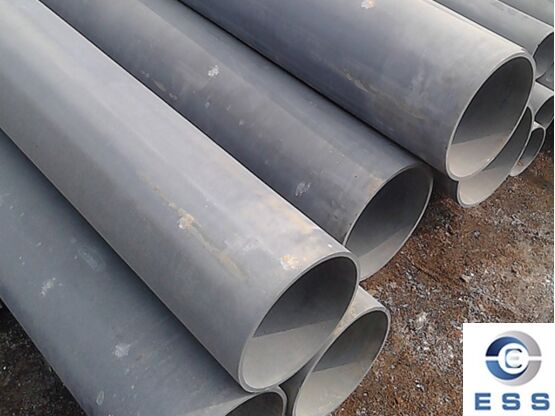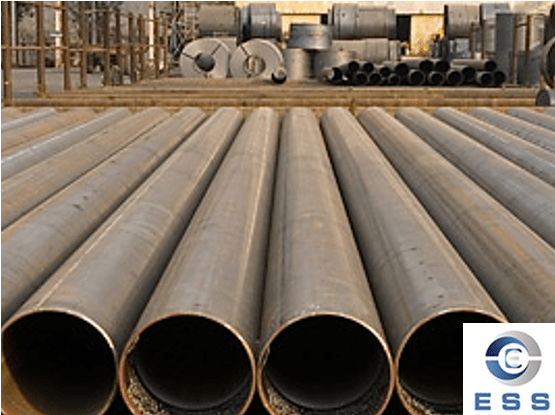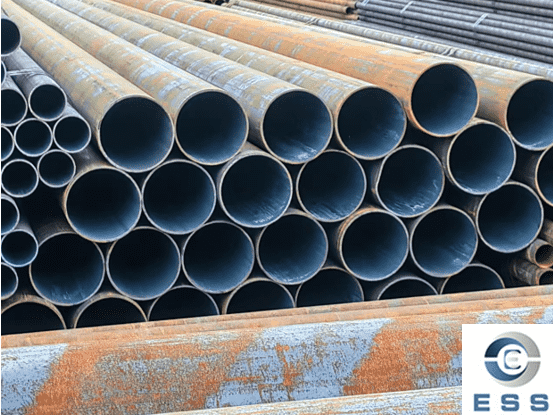
Sch40 mild
steel pipe is a widely used type of steel pipe, combining the
characteristics of standard wall thickness grade (Schedule 40) and low carbon
steel materials, suitable for a variety of industrial scenarios.
What is MS pipe schedule 40
Sch40 mild steel pipe is the product of the
combination of wall thickness standard (Schedule 40) and low carbon steel
materials.
1. Schedule 40
The wall thickness grade defined by the
American ASME standard represents the standard wall thickness under a specific
pipe diameter. The larger the Sch value, the thicker the wall thickness and the
higher the pressure bearing capacity; Sch 40 belongs to the medium wall
thickness grade and is the most widely used. The wall thickness of Sch40
increases with the increase of nominal pipe diameter (NPS), but the ratio of
wall thickness to pipe diameter gradually decreases. Its core feature is “dynamic
adjustment of wall thickness according to pipe diameter”. For example:
1-inch (DN25) pipe outer diameter 33.4mm,
wall thickness 3.38mm;
6-inch (DN150) pipe outer diameter 168.3mm,
wall thickness 7.11mm.
This design not only ensures the
pressure-bearing requirements, but also avoids material waste.
2. Mild steel pipe
Mild steel pipe (MS pipe full form) is a carbon
steel pipe made of low-carbon steel (carbon content ≤0.25%), which has both weldability and processability. Typical
materials such as ASTM A53 Gr.B have a tensile strength of ≥415MPa and a yield strength of ≥240Mpa,
which are sufficient to cope with conventional industrial loads.
MS pipe schedule 40 specifications
|
Sch.40 Pipe Standard Dimensions & Weights (Per Meter)
|
|
Outside Diameter (inch)
|
Outside Diameter (mm)
|
Wall Thickness (mm)
|
Pipe Weight (kg/m)
|
Inside Diameter (mm)
|
Net Weight (kg/m)
|
Total Weight (kg/m)
|
|
3-1/2
|
101.6
|
5.7
|
13.5
|
90.9
|
6.5
|
20.0
|
|
4
|
114.3
|
6.0
|
16.0
|
102.3
|
8.2
|
24.2
|
|
5
|
141.3
|
6.6
|
21.9
|
128.1
|
12.9
|
34.8
|
|
6
|
168.3
|
7.1
|
28.2
|
154.1
|
18.6
|
46.8
|
|
8
|
219.1
|
8.2
|
42.6
|
202.7
|
32.3
|
74.9
|
|
10
|
273.1
|
9.3
|
60.5
|
254.5
|
50.8
|
111.3
|
|
12
|
323.8
|
10.3
|
79.7
|
303.2
|
72.1
|
151.8
|
|
14
|
355.6
|
11.1
|
94.3
|
333.4
|
87.3
|
181.6
|
|
16
|
406.4
|
12.7
|
123.0
|
381.0
|
114.0
|
237.0
|
|
18
|
457.2
|
14.3
|
156.0
|
428.6
|
144.2
|
300.2
|
|
20
|
508.0
|
15.1
|
183.0
|
477.8
|
179.2
|
362.2
|
Typical materials
1. ASTM A53 Gr.B: Seamless/welded
pipe, commonly used for low pressure fluid transportation.
2. ASTM A106 Gr.B: Seamless pipe, high
temperature resistant (≤450℃),
suitable for steam system.
3. API 5L Gr.B: Steel for oil and gas
pipelines.
Performance parameters
1. Mechanical properties (taking ASTM A53
Gr.B as an example)
Tensile strength ≥415
MPa
Yield strength ≥240
MPa
Elongation ≥23%
(gauge length 50mm)
2. Pressure resistance
Hydraulic pressure test pressure formula:
P=2St/DP=2St/D
(S=allowable stress, t=wall thickness,
D=outer diameter)
Example: The maximum working pressure of
NPS 2" Sch40 pipe at 20℃ is about 150 psi (1.03
MPa).
3. Temperature limit
ASTM A106 Gr.B recommends a temperature of
-29℃~450℃.
Manufacturing process
The performance difference of Sch40 mild
steel pipe mainly comes from the manufacturing process
Process: Formed by hot rolling or cold
drawing, without weld defects.
Advantages: High pressure bearing capacity,
suitable for steam, high pressure gas and other scenarios.
Typical material: ASTM A106 Gr.B
(temperature resistance up to 450℃).
2. Welded steel pipe
Process: ERW (resistance welding) or SAW
(submerged arc welding) technology is used.
Advantages: Cost reduction of 30%~50%,
suitable for low-pressure water and gas transportation.
Limitations: The weld is prone to corrosion
starting point, and it needs to be used with galvanizing or coating.
Application scenarios
The application of Sch40 mild steel pipe
spans multiple fields:
1. Fluid transportation system
Municipal water supply: Galvanized
pipes are corrosion-resistant and have a service life of more than 20
years.
Low-pressure steam: ASTM A106 seamless
pipes can withstand ≤2MPa steam pressure.
Natural gas transportation: API 5L Gr.B
pipes meet the needs of medium and low pressure pipelines.
2. Structural engineering
Building scaffolding: The
strength-to-weight ratio of Sch40 pipes is better than that of ordinary
structural steel.
Machinery equipment frame: Modular
structures can be quickly built by bolts or welding.
3. Special fields
Fire protection system: In compliance with
NFPA standards, must pass 1.5 times the working pressure test.
Chemical pipeline: Surface coating of epoxy
resin can withstand weak acid and alkaline media.
Summary
Sch40 mild steel pipe occupies an important
position in low pressure fluid transportation and general structure with
balanced strength, economy and easy processing. When selecting, it is necessary
to comprehensively consider pressure, medium, temperature and corrosion
conditions, and upgrade to Sch80 or alloy material if necessary. Special
attention should be paid to welding quality and anti-corrosion measures during
installation and maintenance to extend service life.
Read more: Difference between mild steel pipe and carbon steel pipe or Common specifications & sizes of mild steel tube













 Eastern Steel Manufacturing Co.,Ltd not only improve product production and sales services, but also provide additional value-added services. As long as you need, we can complete your specific needs together.
Eastern Steel Manufacturing Co.,Ltd not only improve product production and sales services, but also provide additional value-added services. As long as you need, we can complete your specific needs together.










